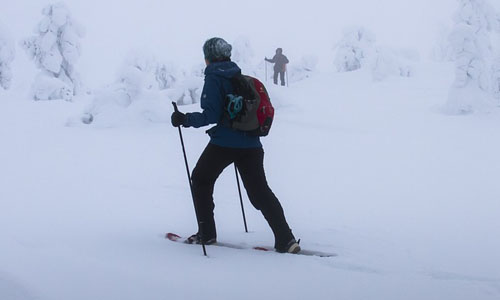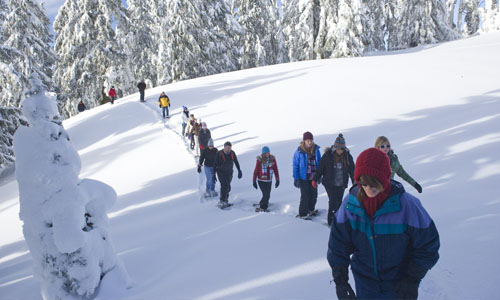Breaking the Trail While Snowshoeing: A Yes Or A No?
Author

Chris shares his passion for cycling, hiking, skiing, and climbing from Buxton, in the Peak District. As a blogger for Outdoor Look, Chris shares outdoor tips and indoor tricks to help you get the most out of your time spent outside. When he's not out adventuring he's making videos or trying to keep up with his 4-year-old son.
 If you’ve never undertaken snowshoeing, I’d suggest you give it a try immediately. It’s considerably more tiresome than hiking, so you should start out slowly on easy, level trails and build up your endurance over the course of time. Buying a pair of snowshoes and poles can be a bit harsh on your pocket, so it’s better to rent the gear you need until you are certain you want to invest in snowshoes.
If you’ve never undertaken snowshoeing, I’d suggest you give it a try immediately. It’s considerably more tiresome than hiking, so you should start out slowly on easy, level trails and build up your endurance over the course of time. Buying a pair of snowshoes and poles can be a bit harsh on your pocket, so it’s better to rent the gear you need until you are certain you want to invest in snowshoes.
Some of you might disagree, but I strongly nurture this belief that winter trails aren’t groomed for snowshoeing like they are for cross-country skiing. If you discover a trail that’s even and less sloppy, you need to find and thank the snowshoers who went on that slope before you. Making your way through an existing trail is far easier than creating a new one. For this very reason, popular snowshoe areas are ideal for beginners, but it’s still important to plan beforehand by keeping an eye on the weather reports.
The essence of snowshoeing lies in breaking the trail. You can trek up and down the white slopes. Cutting new steps can be far more vigorous than walking on a snow-covered feather bed, and you can enjoy the blanket of peacefulness wrapped all-around you. Also, you don’t have to worry about contributing to erosion, as you would in summer. The plants are buried beneath the snow cover.
Have fun, but be careful
 Adventure is directly proportional to the degree of risk associated with it. Before you break the trail, you should shortlist all the areas prone to avalanches. Having comprehensive navigational skills is also a must. The most important thing to do before hitting the slopes is to thoroughly check the avalanche report. Many training centers give avalanche training classes. These would help you to be prepared for the avalanche if and when it occurs. Another important thing to keep in mind when you’re breaking trail is tree wells. Make sure not to break through when you approach a hollow spot near a six-feet-tall tree. Falling into a tree well might result in Snow Immersion Suffocation (SIS). It’s best to assume that all trees in deep snow have some depth of tree wells, and should be avoided.
Adventure is directly proportional to the degree of risk associated with it. Before you break the trail, you should shortlist all the areas prone to avalanches. Having comprehensive navigational skills is also a must. The most important thing to do before hitting the slopes is to thoroughly check the avalanche report. Many training centers give avalanche training classes. These would help you to be prepared for the avalanche if and when it occurs. Another important thing to keep in mind when you’re breaking trail is tree wells. Make sure not to break through when you approach a hollow spot near a six-feet-tall tree. Falling into a tree well might result in Snow Immersion Suffocation (SIS). It’s best to assume that all trees in deep snow have some depth of tree wells, and should be avoided.
Keep your manners intact
Try your luck in a cross-country skiing area if you’re not confident enough to hit the slopes right away. Pay attention to etiquette, especially when it comes to the groomed cross-country ski tracks. Stay off the tracks, If you need to cross them, cross them as cleanly and carefully as possible.
Same is the case with the backcountry, where skiers work hard to skin up the mountain and leave flat tracks for the purpose of reusing. I’d also suggest being careful while walking on a skin track made by skiers as snowshoes tend to make countless holes in the snow, which might create a bumpy track.
Lastly, I would like to bestow the less experienced snowshoers with a few handy tips. The first one amongst them is to go on an REI or ranger-led trip. But if you’re going alone, pay attention to the landscape, check the avalanche report, and follow good etiquette. Breaking your own snowshoe trail is hard work, but it’s well worth the effort. Happy snowshoeing!
Author

Chris shares his passion for cycling, hiking, skiing, and climbing from Buxton, in the Peak District. As a blogger for Outdoor Look, Chris shares outdoor tips and indoor tricks to help you get the most out of your time spent outside. When he's not out adventuring he's making videos or trying to keep up with his 4-year-old son.
- Speed Up Your Post-Hike Recovery with These 6 Essential Tips
- Cycling through Tranquil Roads and Coastal Views on the Isle of Wight
- The Essential Guide to Hiking Safety: 5 Tips Every Hiker Should Know
- Run Smart, Run Strong: Your Guide to Injury-Free Running
- Embrace Biking: Essential Tips for Beginners
Categories
- Sport (28)
- Product Reviews (3)
- Team Outdoor Look (7)
- Mike Wild (2)
- Mike Payton (2)
- Suse Hammond-Pears (3)
- Snowboarding (12)
- Latest Offers (105)
- Shop Talk (1)
- Competitions (7)
- Walking (413)
- Lifestyle Fashion (8)
- Travel (86)
- Kit Guides (176)
- Workwear Clothing (6)
- Safety Workwear (4)
- Health/Fitness (289)
- Skiing (91)
- Great Outdoors (1316)
- Cycling (92)
- January 2025
- December 2024
- November 2024
- October 2024
- September 2024
- August 2024
- July 2024
- June 2024
- May 2024
- April 2024
- March 2024
- February 2024
- January 2024
- December 2023
- November 2023
- October 2023
- September 2023
- August 2023
- July 2023
- June 2023
- May 2023
- April 2023
- March 2023
- February 2023
- January 2023
- December 2022
- November 2022
- October 2022
- September 2022
- August 2022
- July 2022
- June 2022
- May 2022
- April 2022
- March 2022
- February 2022
- January 2022
- December 2021
- November 2021
- October 2021
- September 2021
- August 2021
- July 2021
- June 2021
- May 2021
- April 2021
- March 2021
- February 2021
- January 2021
- December 2020
- November 2020
- October 2020
- September 2020
- August 2020
- July 2020
- June 2020
- May 2020
- April 2020
- March 2020
- February 2020
- January 2020
- December 2019
- November 2019
- October 2019
- September 2019
- August 2019
- July 2019
- June 2019
- May 2019
- April 2019
- March 2019
- February 2019
- January 2019
- December 2018
- November 2018
- October 2018
- September 2018
- August 2018
- July 2018
- June 2018
- May 2018
- April 2018
- March 2018
- February 2018
- January 2018
- December 2017
- November 2017
- October 2017
- September 2017
- August 2017
- July 2017
- June 2017
- May 2017
- April 2017
- March 2017
- February 2017
- January 2017
- December 2016
- November 2016
- October 2016
- September 2016
- August 2016
- July 2016
- June 2016
- May 2016
- April 2016
- March 2016
- February 2016
- January 2016
- December 2015
- November 2015
- October 2015
- September 2015
- August 2015
- July 2015
- June 2015
- May 2015
- April 2015
- March 2015
- February 2015
- January 2015
- December 2014
- November 2014
- October 2014
- September 2014
- August 2014
- July 2014
- June 2014
- May 2014
- April 2014
- March 2014
- February 2014
- January 2014
- December 2013
- November 2013
- October 2013
- September 2013
- August 2013
- July 2013
- June 2013
- May 2013
- April 2013
- March 2013
- February 2013
- January 2013
- December 2012
- November 2012
- October 2012
- September 2012
- August 2012
- July 2012
- June 2012
- May 2012
- April 2012
- March 2012
- February 2012
- January 2012
- December 2011
- November 2011
- October 2011
- September 2011
- August 2011
- May 2010
- April 2010
- March 2010
- February 2010
- January 2010
- November 2009
- October 2009
- September 2009
Submit a Comment